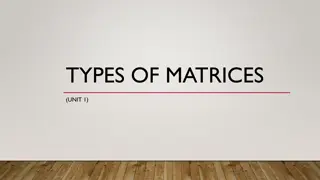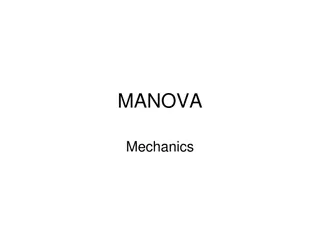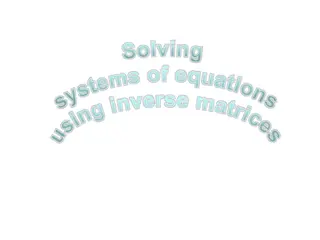AQA Level 2 Certificate in Further Maths
The AQA Level 2 Certificate in Further Maths is designed for high-achieving students to develop advanced skills in algebra, geometry, calculus, matrices, trigonometry, functions, and graphs. The course covers topics like number fractions, decimals, algebraic fractions, coordinate geometry, calculus,
7 views • 9 slides
Exploring Latin Roots through Morpheme Matrices Activity
Engage students in combining Latin morphemes to form words, discussing spelling and pronunciation changes, understanding word meanings, and practicing with sentences. Utilize various morpheme matrices for an interactive learning experience.
0 views • 21 slides
Exporting STATA Results to Excel Using PutExcel Feature
Learn how to utilize the PutExcel feature in STATA to effortlessly export your results to an Excel file. With PutExcel, you can export matrices, stored results, images, estimation tables, and even add formulas for calculations. This tool streamlines the process of transferring statistical data to Ex
3 views • 32 slides
Matrix Systems in Restorative Dentistry: A Comprehensive Overview
Understanding the role of matrices and retainers in restorative dentistry is crucial for achieving optimal results in direct restorative procedures. This article covers the definitions, ideal requirements, functions, and parts of matrices, providing valuable insights into their importance and usage
1 views • 55 slides
Exploring 2x2 Matrices in Political Science: An Irreverent Perspective
Delve into the world of 2x2 matrices in political science with a humorous twist, uncovering their foibles, fallacies, and effectiveness. From youthful rigidity to complex behavioral continuums, this unconventional take on matrices unveils their application in various scenarios like spouse choices, b
0 views • 34 slides
Understanding Matrices: Types, Definitions, and Operations
Matrices are ordered arrays used to express linear equations. Learn about types, definition, equality, and operations like addition, subtraction, and multiplication. Discover matrix equality and the transpose of a matrix, including symmetric and skew-symmetric matrices.
1 views • 17 slides
Understanding Linear Transformations and Matrices in Mathematics
Linear transformations play a crucial role in the study of vector spaces and matrices. They involve mapping vectors from one space to another while maintaining certain properties. This summary covers the introduction to linear transformations, the kernel and range of a transformation, matrices for l
0 views • 85 slides
Understanding Matrices in Precalculus: Order, Augmented Matrix, and Row-Echelon Form
Delve into the world of matrices in Precalculus with a focus on identifying matrix orders, creating augmented matrices for systems of equations, transforming matrices into row-echelon form, and solving linear equations using matrices. Explore elementary row operations, row-echelon form, and reduced
1 views • 37 slides
Understanding Gaussian Elimination Method in Linear Algebra
Gaussian Elimination and Gauss-Jordan Elimination are methods used in linear algebra to transform matrices into reduced row echelon form. Wilhelm Jordan and Clasen independently described Gauss-Jordan elimination in 1887. The process involves converting equations into augmented matrices, performing
4 views • 14 slides
Understanding the Singular Value Decomposition
The Singular Value Decomposition (SVD) is a powerful factorization method for matrices, extending the concept of eigenvectors and eigenvalues to non-symmetric matrices. This decomposition allows any matrix to be expressed as the product of three matrices: two orthogonal matrices and a diagonal matri
0 views • 35 slides
Understanding MANOVA: Mechanics and Applications
MANOVA is a multivariate generalization of ANOVA, examining the relationship between multiple dependent variables and factors simultaneously. It involves complex statistical computations, matrix operations, and hypothesis testing to analyze the effects of independent variables on linear combinations
0 views • 16 slides
Immobilization of Enzymes in Biochemistry
Enzyme immobilization involves confining enzyme molecules to a distinct phase from substrates and products, attaching them to solid matrices for enhanced specificity and reduced inhibition. Inert polymers or inorganic materials are used as carrier matrices with methods like physical adsorption onto
0 views • 24 slides
Understanding Singular Value Decomposition and the Conjugate Gradient Method
Singular Value Decomposition (SVD) is a powerful method that decomposes a matrix into orthogonal matrices and diagonal matrices. It helps in understanding the range, rank, nullity, and goal of matrix transformations. The method involves decomposing a matrix into basis vectors that span its range, id
0 views • 21 slides
Understanding Hessian-Free Optimization in Neural Networks
A detailed exploration of Hessian-Free (HF) optimization method in neural networks, delving into concepts such as error reduction, gradient-to-curvature ratio, Newton's method, curvature matrices, and strategies for avoiding inverting large matrices. The content emphasizes the importance of directio
0 views • 31 slides
Introduction to Matrices in Mathematical Analysis
Matrices play a crucial role in simplifying complex systems of equations and are well-suited for systematic mathematical treatments and computer computations. This introduction covers the definition of matrices, their properties such as size and notation, and various types of matrices including colu
0 views • 77 slides
Understanding Python ML Tools: NumPy and SciPy
Python is a powerful language for machine learning, but it can be slow for numerical computations. NumPy and SciPy are essential packages for working with matrices efficiently in Python. NumPy supports features crucial for machine learning, such as fast numerical computations and high-level math fun
0 views • 11 slides
Linear Algebra Review for Big Data Summer Institute
Join Rupam Bhattacharyya at the Big Data Summer Institute for a comprehensive review of linear algebra concepts. Explore topics such as matrix notation, special matrices, shapes of matrices, and matrix operations. Gain valuable insights for applications in big data analysis and machine learning.
0 views • 18 slides
Understanding Matrices and Solving Equations in Electrical Engineering
Matrices play a crucial role in solving linear equations in Electrical Engineering applications. Learn about matrix structures, special matrices, inverses, transposes, system of linear equations, and solving methods using MATLAB/Python. Explore the application of matrices in solving voltage-current
1 views • 24 slides
Distribution and Occurrence of Trace Elements in Urban Wetland: A Case Study of Deepor Beel, Assam, India
This study focuses on the distribution and occurrence of trace elements and pharmaceutical pollutants in the urban wetland of Deepor Beel in Assam, India. The research investigates the presence of emerging contaminants like pharmaceuticals and personal care products, providing insights into the poll
0 views • 10 slides
Understanding Sequence Alignment and Scoring Matrices
In this content, we dive into the fundamentals of sequence alignment, Opt score computation, reconstructing alignments, local alignments, affine gap costs, space-saving measures, and scoring matrices for DNA and protein sequences. We explore the Smith-Waterman algorithm (SW) for local sequence align
0 views • 26 slides
Affinity Chromatography: A Breakthrough in Biochemical Research
Affinity chromatography, developed in the 1930s by A. Wilhelm Tiselius, is a vital technique for studying enzymes and proteins. It relies on the specific affinity between biochemical compounds and utilizes matrices like agarose for binding sites. Ligands such as amino and hydroxyl groups play crucia
1 views • 27 slides
Understanding Rank in Matrices
Rank in matrices represents the maximum number of independent columns, with implications for pivot columns, basic variables, and free variables. The rank of a matrix is essential for determining its properties and dependencies. Learn about rank-deficient matrices, basic versus free variables, and mo
0 views • 7 slides
Understanding Eigenvalues in Quantum Information
Explore the eigenvalues of sums of non-commuting random symmetric matrices in the context of quantum information. Delve into the complexities of eigenvalue distributions in various scenarios, including random diagonals, orthogonal matrices, and symmetric matrix sums. Gain insights into classical and
0 views • 24 slides
Learning-Based Low-Rank Approximations and Linear Sketches
Exploring learning-based low-rank approximations and linear sketches in matrices, including techniques like dimensionality reduction, regression, and streaming algorithms. Discusses the use of random matrices, sparse matrices, and the concept of low-rank approximation through singular value decompos
0 views • 13 slides
Understanding Algebra: Operations, Patterns, and More
Explore the fundamental concepts of algebra through sets, operations, patterns, axioms, identities, examples, inverses, groups, modular arithmetic, and matrices. Delve into the world of square matrices and gain insights into various algebraic structures.
0 views • 20 slides
Basic Principles of Medical Geology and Trace Elements Overview
This session delves into the fundamental principles of medical geology and its impact on human health. It explores how exposure to certain elements in the geologic environment can affect well-being, emphasizing pathways of trace elements into the body and their consequences. Dr. Patrick Asamoah Saky
0 views • 26 slides
Overview of Minerals and Trace Elements in Human Nutrition
Minerals and trace elements play essential roles in the human body, categorized into groups based on their functions and requirements. Nutritional minerals like calcium, phosphorus, and magnesium are needed in larger amounts, while trace elements such as zinc and iron are required in smaller quantit
0 views • 50 slides
Understanding General Equilibrium Models and Social Accounting Matrices
General Equilibrium Models (CGE) and Social Accounting Matrices (SAM) provide a comprehensive framework for analyzing economies and policies. This analysis delves into how CGE models help simulate various economic scenarios and their link to SAM, which serves as a key data input for the models. The
0 views • 50 slides
Importance of Outdoor Ethics and Leave No Trace Principles
Outdoor ethics play a crucial role in preserving natural areas for future generations. The increase in visitors to wilderness areas highlights the need for responsible behavior. Integrating Leave No Trace principles into programs like BSA emphasizes the value of conservation and respect for the outd
0 views • 14 slides
MATLAB Basics for Electrical Engineering Students
In this instructional content from the Government Polytechnic West Champaran Department of Electrical Engineering, students are introduced to the fundamentals of MATLAB. Topics covered include transposing matrices, concatenating matrices, matrix generators, arrays, entering matrices, and manipulatin
0 views • 48 slides
Understanding Biological Uptake of Trace Elements in Natural Systems
Explore the connection between stoichiometric plasticity and trace metal distribution, investigate microbial acquisition systems, analyze modes of metal uptake, and address co-limitations and interactions within organisms. Utilize molecular tools to enhance knowledge on trace element bioavailability
0 views • 5 slides
Understanding Hazard Matrices and Impact-Based Forecasting
Hazard matrices are essential tools for coordinating emergency preparedness and response by categorizing primary, secondary, and tertiary effects of hazards. Impact matrices help organizations assess risks and determine potential impacts of events, allowing for better planning and mitigation strateg
0 views • 12 slides
Transparent and Efficient CFI Enforcement with Intel Processor Trace
This research discusses Control Flow Integrity (CFI) enforcement to combat control flow hijacking attacks. It explores methods for runtime CFI enforcement, including instrumented checking and transparent monitoring. The study delves into trace mechanisms, buffer management strategies, and when to tr
0 views • 32 slides
Solving Systems of Equations using Inverse Matrices
Learn how to solve systems of equations using inverse matrices, find the determinant of matrices, use matrix multiplication, calculate the inverse matrix, and apply it to solve simultaneous equations. Explore examples and applications in investment scenarios.
0 views • 14 slides
Trace-Driven Cache Simulation in Advanced Computer Architecture
Trace-driven simulation is a key method for assessing memory hierarchy performance, particularly focusing on hits and misses. Dinero IV is a cache simulator used for memory reference traces without timing simulation capabilities. The tool aids in evaluating cache hit and miss results but does not ha
0 views • 13 slides
Input Elimination Transformations for Scalable Verification and Trace Reconstruction
This work introduces new input elimination techniques for scalable model checking in industrial applications, focusing on trace reconstruction. The transformations aim to make the netlist more tractable for solving, involving various algorithms such as retiming, phase abstraction, and bitwidth reduc
0 views • 27 slides
Enhancing Precision and Accuracy in Trace Element Analysis Using EPMA Techniques
This research focuses on improving precision and accuracy for trace elements through advanced methods like MAN (mean atomic number) and MPB (multi-point background). By optimizing background measurements and calibration techniques, researchers aim to enhance the sensitivity and reliability of trace
0 views • 16 slides
Bringing Leave No Trace to Scouting: Expectations and Training Sessions
Encouraging Leave No Trace practices in Scouting is essential. This guide covers expectations for instructors, training sessions, BSA trainings, promotion strategies, and leadership positions related to Leave No Trace. From promoting the message to in-depth training opportunities, the focus is on in
0 views • 12 slides
Understanding Trace Tables for Algorithm Testing
Trace tables are a valuable technique used to test algorithms step by step and identify logic errors. They involve using truth tables to track variable values or conditions. This content provides insights into trace tables, correcting errors in pseudocode, using examples for variable tracking, and c
0 views • 9 slides
Understanding Directed Graphs and Adjacency Matrices in Discrete Structures
Explore the concepts of binary relations, directed graphs, adjacency matrices, transitive closure, and walks in the context of discrete structures. Learn how vertices, edges, in-degrees, out-degrees, and self-loops are defined in directed graphs. Understand the importance of adjacency matrices in re
0 views • 28 slides







































